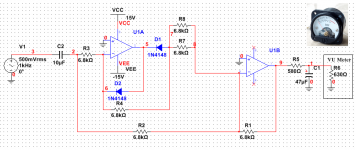I want to buy a pair of one of those chinese VU meters and use a precision rectfier to drive it will it work? If so, what should be the slew rate and also the value of C1?

Attachments
Last edited:
Here's a golden oldie app note.
https://www.ti.com/lit/an/sboa068/sboa068.pdf?ts=1649796168775&ref_url=https%3A%2F%2Fwww.google.com%2F
And this one may help.
https://sound-au.com/appnotes/an001.htm
https://www.ti.com/lit/an/sboa068/sboa068.pdf?ts=1649796168775&ref_url=https%3A%2F%2Fwww.google.com%2F
And this one may help.
https://sound-au.com/appnotes/an001.htm
Last edited:
I came across this on ebay:
https://www.ebay.com/itm/265415011715?hash=item3dcbf7ad83:g:rb0AAOSwUwhhmWrb&amdata=enc:AQAHAAAA8K2Li/KzDlDY1A+4RLeQbxbPjBs2/69NHUscX9nMv68qorLO3r3FmBHZ03vG4fNf0f5qdl2CkAOxqTRFmQz83WNB7O5aBNAcxO8CllSmPaXKMdBt5jkU2FBk0PvWKeQkVfuFKM9VT8nuJ3OwYYZA2iZRk1euy1c1k59uK5LwmX1anNEfXFzN+2TVh07ZBe/+VEfsmChMhE6icPm4fMZ4cKDA0eJLjpsLnNenNhM/IYJHUAN84EYOn/ikQISv+M3BNp0cVR+sMcJsdjKIP1lPa6AWCnrOB08riFydyV4VBoNgObBw/2jJUK/Yex0QMXXQzw==|tkp:BFBMltbUxrVg
Is This a joke?
Check out the scale.
Selling price is >$300!
Read the descriptions!
Art
https://www.ebay.com/itm/265415011715?hash=item3dcbf7ad83:g:rb0AAOSwUwhhmWrb&amdata=enc:AQAHAAAA8K2Li/KzDlDY1A+4RLeQbxbPjBs2/69NHUscX9nMv68qorLO3r3FmBHZ03vG4fNf0f5qdl2CkAOxqTRFmQz83WNB7O5aBNAcxO8CllSmPaXKMdBt5jkU2FBk0PvWKeQkVfuFKM9VT8nuJ3OwYYZA2iZRk1euy1c1k59uK5LwmX1anNEfXFzN+2TVh07ZBe/+VEfsmChMhE6icPm4fMZ4cKDA0eJLjpsLnNenNhM/IYJHUAN84EYOn/ikQISv+M3BNp0cVR+sMcJsdjKIP1lPa6AWCnrOB08riFydyV4VBoNgObBw/2jJUK/Yex0QMXXQzw==|tkp:BFBMltbUxrVg
Is This a joke?
Check out the scale.
Selling price is >$300!
Read the descriptions!
Art
Here is another link for just vu meter.
https://www.ebay.com/itm/124411352185?hash=item1cf77e9479:g:yyoAAOSwNSxVPfSM
Art
https://www.ebay.com/itm/124411352185?hash=item1cf77e9479:g:yyoAAOSwNSxVPfSM
Art
If you rectify, it becomes DC.
Put a resistor if needed, connect in parallel to speakers.
It is AC voltmeter really.
Put a resistor if needed, connect in parallel to speakers.
It is AC voltmeter really.
GBP 240 is for a meter in box, with lights, for decorative use by audiofools.....there is a sucker born every minute.
The Chinese ones at about $10 should be enough, if you want them to dance around.
More precision?
Buy 10 VAC meters, and use those. or match that, full power is 10 VAC.
The Chinese ones at about $10 should be enough, if you want them to dance around.
More precision?
Buy 10 VAC meters, and use those. or match that, full power is 10 VAC.
I have some vintage VU meters from AKAI M-8 etc. old tube tape recorders. Those meters were simply hooked in parallel with speaker output with (from memory) a 5K resistor in one leg. What does the resistor do? Can this wiring be adapted or modified for use with line-level (etc.) audio signals? Or does the meter need speaker levels to move?Put a resistor if needed, connect in parallel to speakers.
VU meters are 0-10 VAC, with a different scale to show VU, IIRC.
Signal from line level is in 25 mV to 400 mV range, IIRC, so you will need an amp to use those meters in the worst case.
Plenty of LED kits, and graphic meters using plain ICs, Arduino etc. exist.
Look them up, maybe you can use them to monitor input signal levels instead of old VU meters.
Signal from line level is in 25 mV to 400 mV range, IIRC, so you will need an amp to use those meters in the worst case.
Plenty of LED kits, and graphic meters using plain ICs, Arduino etc. exist.
Look them up, maybe you can use them to monitor input signal levels instead of old VU meters.
If you want to learn something about real VU meters and how to make those simple Ebay toys work better, read some facts and figures about Volume Units and how they are measured professionally: https://classic-audio.co.uk/articles/vu-meter/
There should be more than enough info and inspiration there to get you started on your own project, given that the real meters are not simple or cheap moving coil types (the real-deal meters are actually quite expensive!)
There should be more than enough info and inspiration there to get you started on your own project, given that the real meters are not simple or cheap moving coil types (the real-deal meters are actually quite expensive!)
. . and the ballistic response is part of the spec, too. That's so an experienced engineer can sit down at an unfamiliar rig and immediately know something useful about signal levels.
Best Regards
Best Regards
- Home
- Amplifiers
- Solid State
- Analog VU meter driver
